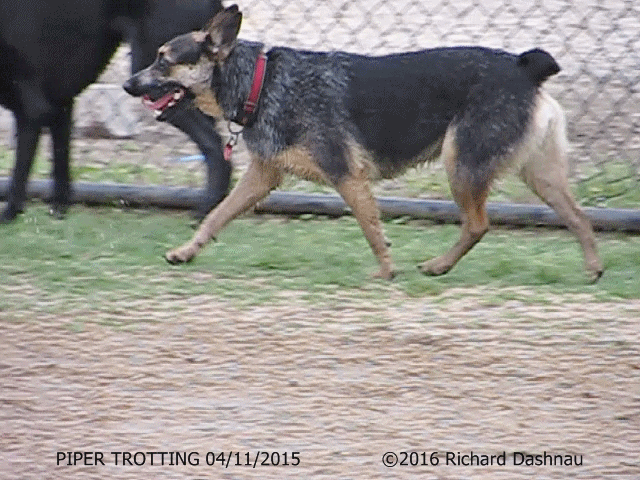
I
never tire of seeing an alligator walking on land. The way
an alligator
walks on land has been defined as a "slow trot". That may
sound
confusing.
A "trot" is one way that a tetrapod (4-footed
animal) can move on land. A trot is defined as moving with
legs in
diagonal pairs--that is, a front leg
and the back leg of the
opposite side move forward together. In a faster animal-like
a dog-this
is usually accompanied by the animal leaving the ground
briefly as
demonstrated in this animated gif of my dog, Piper,
trotting. Compare
how her
opposite-side legs move with those of the alligators below.
Alligator
or crocodylian walking physiology has been studied many times.
I've
gotten some information from two of these studies. One of them is
"LOCOMOTION IN ALLIGATOR
MISSISSIPPIENSIS: KINEMATIC EFFECTS OF SPEED
AND POSTURE AND THEIR RELEVANCE TO THE SPRAWLING-TO-ERECT
PARADIGM", by
Stephen M. Reilly* AND
Jason A. Elias. I've referred to this in
2009 on another of my pages here.
Samples
in this study show that alligators normally use a high walk to move
longer distances, while they'll use the "sprawling" posture for short
distances.(p 2568) When I watched the
alligator
with the deer carcass, it attempted to high walk first, but kept
stepping on the carcass. Finally, it started shoving the carcass,
starting
with a sprawling crawl, and pushing the
carcass in front of it. This
prevented the carcass from getting under the alligator. The alligator
then tried to lift its body higher, while still pushing the carcass. More
of this incident can be
seen on another of my pages here.
This study states that alligators prefer the high walk in a "walking
trot gait" to move over land.
In the study, a "trot" is defined as "using coordinated
footfalls
of
diagonal limb couplets". That is, front leg and opposite side back leg
move forward at the same time (p. 2562). Also, alligators use a
"trot" whether they high walk, or low sprawl.
Also,
the "low sprawl" walk in alligators does not work like the sprawling
gait of salamanders or lizards. It is more like the alligator's high
walk, but just in a lower profile.
(p 2571) .

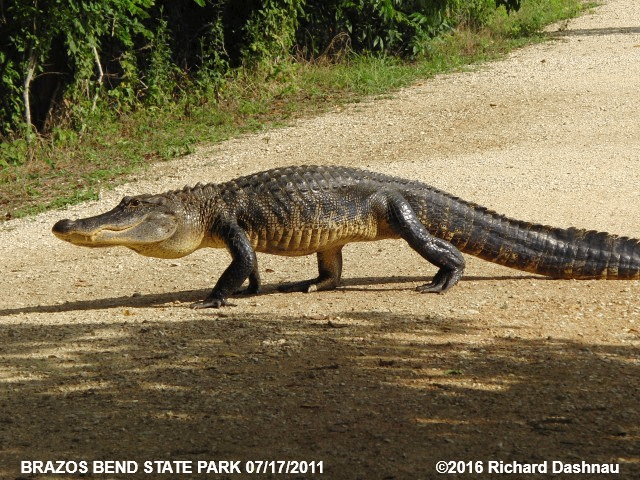
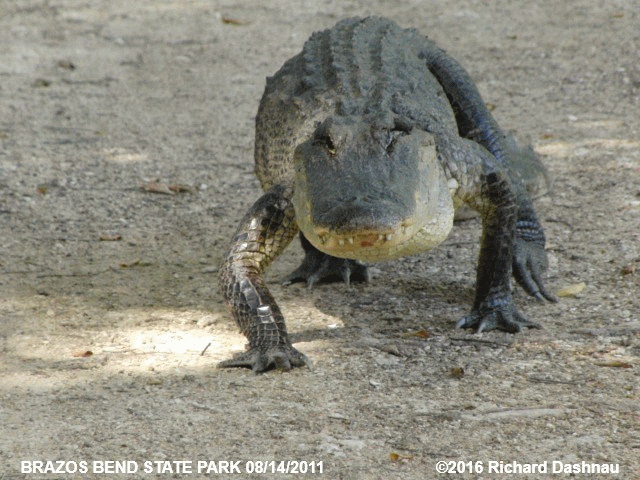
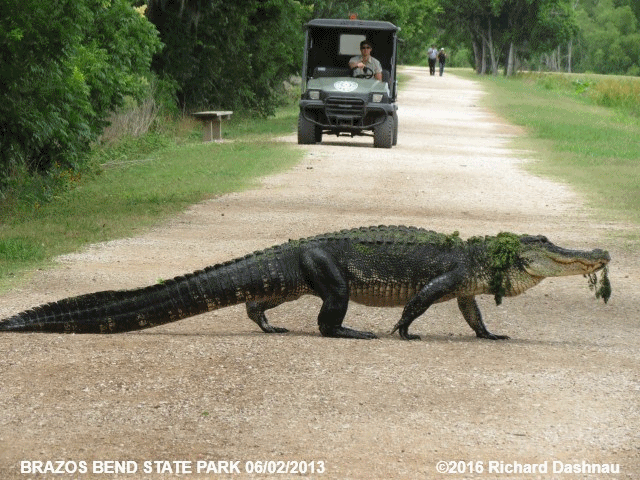
07/03/2011
07/17/2011
08/14/2011
06/02/2013
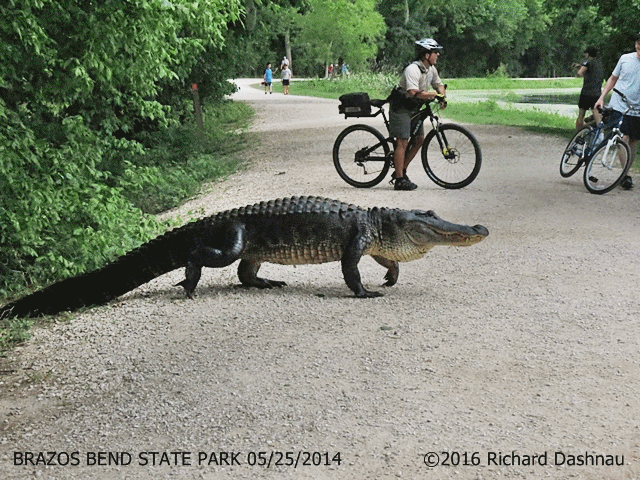 -
- -
-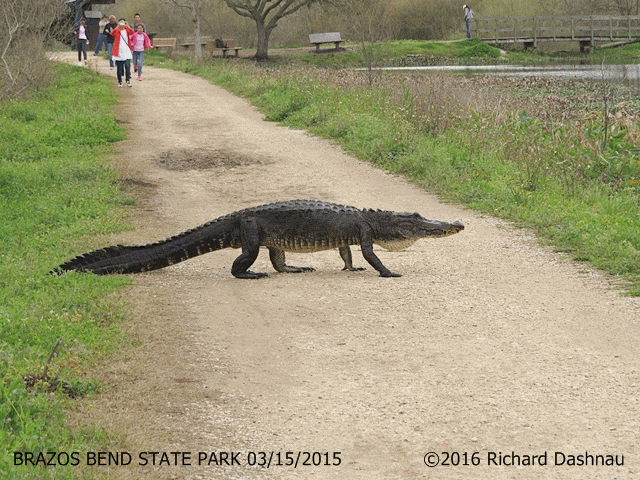 -
-
05/25/2014
04/19/2015
03/15/2015
04/19/2015
Another
study is "The tale of the tail: limb function and locomotor
mechanics
in Alligator mississippiensis" by, Jeffrey S. Willey1,*, Audrone
R.
Biknevicius2,†, Stephen M. Reilly1 and Kathleen D. Earls2
Observations in this study include:
While an alligator is
walking it has to drag its tail, which is about 28 percent of
its body mass.(p. 553)(p. 560)
While an alligator is walking about 16% of the forelimb and 19%
of the hindlimb lift force is pushing to the side.
During
a high walk, the diagonal limbs (those touching the ground at
any time)
support 36.8% (front leg) and 51.3%(back leg) of the alligator's
weight. The
remaining 11.8% is supported by the tail.(p 557)
Any
side-to-side movements made by the alligator as it walks may
help
recover about 7% of the energy it expends by lifting its body
and
dragging its tail. (p.562)
I'v
seen at least one other study that indicates that the osteoderms
in an
alligator's back (each bump on the back of an alligator is
covering a
disk-shaped bone, called an osteoderm) helps
keep the back
rigid-especially during the high walk. The osteoderms form a
support surface, working with connective tissue and the skeleton,
to
stop the back from sinking in the middle, and
also to stop it from
bending side-to-side too much.
These
animated gifs are examples of alligators walking on land at the
park. I never
get tired of seeing this (and I also have video clips...I've been
lucky enough to see this many times). The
better animated gifs above were made from photos shot at 30 frames
per second.
These animated gifs illustrate the look of the high walk. The
sequence with the deer is included because of the
way the alligator
pushed the deer across the trail, illustrating the "sprawling
trot". I think that looking at
the single frames one after another helps show the slight
up-and-down
shift, and also the
forward "pull" of the tail with the back legs.
This trot is what makes an alligator track
easily-recognizable. The image below shows an alligator track.
The
drag mark from the tail is clearly-visible.
It's possible to see
the back foot (with 4 toes) right next to and behind the front
foot
(smaller, with 5 toes). The animated gif next shows a single step
highlighted.
Go back to my main alligator page, Alligators
Go
back to my home page, Welcome
to rickubis.com
Go
back
to the RICKUBISCAM
page.
Go
back
to the See the
World
page.